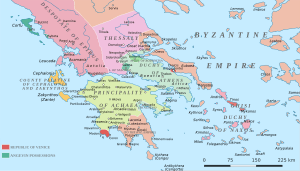Nicholas III of Saint-Omer facts for kids
Quick facts for kids Nicholas of Saint-Omer |
|
|---|---|
| Lord of one half of Thebes | |
| Tenure | Before 1299 – 1311 |
| Predecessor | Otho of Saint-Omer |
| Successor | Catalan conquest |
| Lord of one third of Akova | |
| Tenure | Before 1290 – 1314 |
| Predecessor | John of Saint-Omer |
| Marshal of Achaea | |
| Tenure | Before 1290 – 1314 |
| Predecessor | John of Saint-Omer |
| Died | 30 January 1314 |
| Spouse | Guglielma Orsini |
| Dynasty | Saint-Omer |
| Father | John of Saint-Omer |
| Mother | Margaret of Passavant |
| Religion | Roman Catholic |
Nicholas III of Saint-Omer (died January 30, 1314) was a very important and powerful leader in Frankish Greece. He was the main military leader, called the Marshal, of the Principality of Achaea. He also ruled over parts of Akova and Thebes. Nicholas served three times as a special governor, known as a bailli, for the Principality of Achaea.
Contents
Nicholas's Early Life and Role
Nicholas was the son of John of Saint-Omer, who was also a Marshal in the Principality of Achaea. His mother was Margaret of Passavant. His grandfather, Bela of Saint-Omer, first received land in Thebes from the Duke of Athens.
When his father died before 1290, Nicholas took over his roles. He inherited a part of the Barony of Akova. He also gained large areas of land in Messenia. Most importantly, he became the Marshal of Achaea, a top military position.
Nicholas's Rise to Power
Nicholas fought in battles during 1291 and 1292. These fights were against the Byzantine Greeks from the Despotate of Epirus. Later, he inherited control of half of Thebes from his uncle, Otho of Saint-Omer. This happened before 1299.
Because of his land and military role, Nicholas became very influential. He gave advice on important matters in Frankish Greece. For example, he suggested that Guy II de la Roche, the young Duke of Athens, marry Matilda of Hainaut. She was the daughter of Princess Isabella of Villehardouin. This marriage helped improve relations between two powerful Greek states.
Serving as a Bailli
From 1300 to 1302, Nicholas served as the bailli of Achaea. A bailli was like a governor or viceroy. He ruled while Princess Isabella was away in Italy. He worked for King Charles II of Naples, who was the ruler of Achaea.
In 1301, Princess Isabella married Philip of Savoy. Philip quickly became unpopular. He was arrogant and ignored the local customs. When Philip arrested the chancellor, Benjamin of Kalamata, Nicholas spoke up. He strongly protested Philip's actions. Isabella and Philip's advisors had to step in to stop a fight.
Military Campaigns and Influence
In 1302 and 1303, Nicholas joined his leader, Guy II of Athens, in Thessaly. They helped the local ruler, John II Doukas, fight off an invasion. They pushed back the invaders. The Frankish army even raided land near Thessalonica. They left when Empress Yolande of Montferrat asked them to.
In 1303 and 1304, King Charles II of Naples attacked Epirus. The ruler of Epirus, Anna Kantakouzene, refused to accept Naples' rule. Nicholas joined the Achaean forces with Philip of Savoy. They tried to capture the capital city, Arta. However, they lost many soldiers and did not succeed.
Charles wanted to attack again the next spring. But Anna of Epirus paid Philip of Savoy to stay home. Nicholas advised Philip to call a meeting in Corinth as an excuse. When Philip left for Italy later that year, Nicholas became the bailli again. He held this position until 1307. Then, the new Prince, Philip I of Taranto, chose Guy II of Athens instead.
Supporting Margaret and Later Years
Nicholas also supported Princess Isabella's younger sister, Margaret of Villehardouin. Margaret had many enemies because she also claimed rights to the Principality. In 1304, Nicholas helped Margaret get some of her husband's inheritance. Her husband was Richard Orsini, the count of Cephalonia.
Some historical records suggest Nicholas served as bailli one more time after 1311. He might have held the role until his death. However, this could be a mix-up with his earlier times as bailli.
Nicholas married Guglielma Orsini after 1294. She was the widow of John Chauderon. They did not have any children. Nicholas died on January 30, 1314. His death meant the end of the Saint-Omer family line.
Images for kids
Sources
- Bon, Antoine (1969) (in fr). La Morée franque. Recherches historiques, topographiques et archéologiques sur la principauté d'Achaïe. Paris: De Boccard. OCLC 869621129. http://cefael.efa.gr/detail.php?site_id=1&actionID=page&serie_id=BefarA&volume_number=213&issue_number=1.
- Longnon, Jean (1969). "The Frankish States in Greece, 1204–1311". In Setton, Kenneth M.. A History of the Crusades, Volume II: The Later Crusades, 1189–1311 (Second ed.). Madison, Milwaukee, and London: University of Wisconsin Press. pp. 234–275. ISBN 0-299-04844-6. http://digicoll.library.wisc.edu/cgi-bin/History/History-idx?type=article&did=History.CrusTwo.i0021&id=History.CrusTwo.
- Trapp, Erich (1990). "24700. Σαῖντ ̓Ομέρ, Νικόλας IIΙ. ντὲ". Prosopographisches Lexikon der Palaiologenzeit 10. Vienna: Verlag der Österreichischen Akademie der Wissenschaften.
| Preceded by Otho of Saint-Omer |
Lord of one half of Thebes before 1299 – 1311 |
Catalan conquest |
| Preceded by John of Saint-Omer |
Lord of one third of Akova before 1290 – 1314 |
Extinction of the Saint-Omer line |
| Preceded by Richard Orsini |
Angevin bailli in the Principality of Achaea 1300–1302 |
Vacant
Direct administration by Prince Philip of Savoy
Title next held by
himself |
| Vacant
Direct administration by Prince Philip of Savoy
Title last held by
himself |
Angevin bailli in the Principality of Achaea 1305–1307 |
Succeeded by Guy II de la Roche |
| Preceded by Gilles de la Plainche |
Angevin bailli in the Principality of Achaea after 1311–1314 |
Succeeded by Nicholas le Maure |



